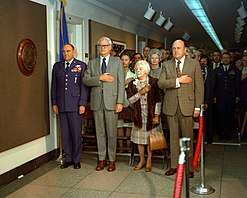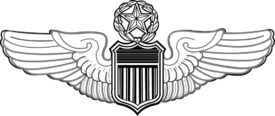John Dale Ryan
General John Dale Ryan (December 10, 1915 – October 27, 1983) was the seventh Chief of Staff of the United States Air Force. As chief of staff of the U.S. Air Force, General Ryan served in a dual capacity. He was a member of the Joint Chiefs of Staff, which, as a body, acts as the principal military advisers to the president, the National Security Council, and the Secretary of Defense. In his other capacity, he was responsible to the Secretary of the Air Force for managing the vast human and materiel resources of the world's most powerful aerospace force.
John Dale Ryan | |
|---|---|
.jpg) General John Dale Ryan | |
| Nickname(s) | "Three-fingered Jack" |
| Born | December 10, 1915 Cherokee, Iowa |
| Died | October 27, 1983 (aged 67) Lackland Air Force Base, Texas |
| Buried | |
| Allegiance | United States |
| Service/ | United States Air Force |
| Years of service | 1938–1973 |
| Rank | General |
| Commands held | Chief of Staff of the United States Air Force Vice Chief of Staff of the United States Air Force Pacific Air Forces Strategic Air Command Second Air Force Sixteenth Air Force 810th Air Division 97th Bombardment Wing 509th Bombardment Group 2d Bombardment Group |
| Battles/wars | World War II Vietnam War |
| Awards | Air Force Distinguished Service Medal (5) Army Distinguished Service Medal Silver Star (2) Legion of Merit Distinguished Flying Cross (2) Air Medal (6) Full list |
| Relations | General Michael E. Ryan (son) |
In May 1972, Ryan was the subject of one of President Richard Nixon's more severe rants.[1]
Early life
John Dale Ryan was born in Cherokee, Iowa, on December 10, 1915. Following graduation from Cherokee Junior College in 1934, he entered the United States Military Academy, played varsity football,[2][3] and graduated in 1938.[4] He next attended pilot training in Texas at Randolph and Kelly fields, and received his pilot wings in 1939.
Military career

Ryan remained at Kelly Field as a flight instructor for approximately two years. From January 1942 until August 1943, he was director of training at Midland Army Airfield, Texas, and was instrumental in establishing an advanced bombardier training school. His next assignment was as operations officer for the Second Air Force at Colorado Springs, Colorado. In February 1944, he was transferred to Italy, where he commanded the 2d Bombardment Group and later became operations officer for the 5th Bombardment Wing, Fifteenth Air Force. While commanding the 2d Bombardment Group he lost a finger to enemy anti-aircraft fire. Later on, this resulted in his nickname, sometimes used derisively, "Three-fingered Jack."
Ryan returned to Texas in April 1945, and became deputy air base commander at Midland Army Airfield. In September, he was assigned to the Air Training Command at Fort Worth and Randolph Field, where he remained until April 1946, when he assumed duties with the 58th Bombardment Wing and participated in the Bikini Atoll atomic weapons tests.
From September 1946 to July 1948, he was assistant chief of staff for pilots of the 58th Bombardment Wing and then Eighth Air Force director of operations. For the next three years, he commanded the 509th Bombardment Group at Walker Air Force Base, New Mexico. Between July 1951 and June 1956, Ryan commanded the 97th Bombardment Wing and the 810th Air Division, both at Biggs Air Force Base, Texas, and the 19th Air Division at Carswell Air Force Base, Texas.

Ryan became director of materiel for the Strategic Air Command in June 1956, and four years later assumed command of SAC's Sixteenth Air Force in Spain. In July 1961, he was named commander of the Second Air Force at Barksdale Air Force Base, Louisiana.
In August 1963, Ryan was assigned to the Pentagon as Inspector General of the Air Force. A year later, he was named vice commander in chief of the Strategic Air Command (SAC) at Offutt Air Force Base, Nebraska, and in December 1964, became its fourth commander in chief, the first educated at West Point.[4] He was assigned as commander in chief, Pacific Air Forces, in February 1967.
Ryan returned to the Pentagon as Vice Chief of Staff in August 1968, and became Chief of Staff in August 1969. One of the more controversial moves of his tenure was the disbandment of the U.S. Air Force Pipes and Drums, the only free-standing, full-time pipe band in the U.S. armed forces.
Ryan's tenure as commander of PACAF and Air Force Chief of Staff also engendered controversy when he was described as one of a group that helped destroy General Jack Lavelle's career after Lavelle gave fighter pilots permission to shoot back at bona fide threats, something previously denied them by rules of engagement. This was also related to the court-martial of Colonel Jack Broughton, after Broughton attempted to protect one of his pilots who shot back at an anti-aircraft position also in apparent violation of rules of engagement. Ryan's "undue command influence" later resulted in the overturning and expungement of Broughton's conviction by the USAF Board for the Correction of Military Records.[5]
Awards and decorations



| Personal decorations | |
| Air Force Distinguished Service Medal with four bronze oak leaf clusters[6] | |
| Army Distinguished Service Medal[6] | |
| Silver Star with bronze oak leaf cluster[6] | |
| Legion of Merit[6] | |
| Distinguished Flying Cross with bronze oak leaf cluster[6] | |
| Air Medal with silver oak leaf cluster | |
| Purple Heart | |
| Campaign and service medals | |
| American Defense Service Medal | |
| American Campaign Medal | |
| European-African-Middle Eastern Campaign Medal with four bronze campaign stars | |
| World War II Victory Medal | |
| National Defense Service Medal with bronze service star | |
| Armed Forces Expeditionary Medal | |
| Vietnam Service Medal with two bronze service stars | |
| Service, training, and marksmanship awards | |
| Air Force Longevity Service Award with silver and two bronze oak leaf clusters | |
| Foreign awards | |
| French Legion of Honour, Commandeur Medal | |
| French World War II Croix de Guerre with bronze palm | |
| Chinese Order of the Cloud and Banner, 1st Grade with Special Grand Cordon | |
| Chinese Order of the Cloud and Banner, 2nd Grade with Grand Cordon | |
| South Korean Order of National Security Merit, Tong-il Medal | |
| National Order of Vietnam, Commander | |
| National Order of Vietnam, Knight | |
| Vietnam Gallantry Cross with palm | |
| Great Star for Military Merit, Chile | |
| Greek Order of the Phoenix, Grand Cross | |
| Spanish Order of Aeronautical Merit, Grand Cross with Red Decoration | |
| Brazilian Order of Aeronautical Merit, Grand Official | |
| Vietnam Gallantry Cross Unit Award | |
| Vietnam Campaign Medal | |
Other achievements
In December 1962, he joined a select group of athletes, who have been successful in their professional careers since their college football days, when he was chosen a member of the Sports Illustrated Silver Anniversary All-American team.[7] He received an honorary doctor of laws degree from Creighton University, Omaha, Nebraska, on May 30, 1966; and an honorary doctor of laws degree from the University of Akron, Ohio, on June 5, 1967.
In July 1971, Ryan became the first foreign dignitary to receive the Golden Wings of the Philippine Air Force. Additional foreign decorations are Chilean Military Star of the Armed Forces, Class of Great Star for Military Merit.
Ryan's son, General Michael E. Ryan, also held the position of Chief of Staff. Unlike the elder Ryan's career as bomber pilot, the younger Ryan (b. 1941) and his brother John (1940–1970) were both fighter pilots.
Family and death
Ryan died of a heart attack at age 67 on October 27, 1983, while hospitalized at the Air Force's Wilford Hall Medical Center adjacent to Lackland AFB in San Antonio, Texas.[8] He was later buried with full military honors at the United States Air Force Academy Cemetery in Colorado Springs, Colorado. He was survived by his wife, the former Jo Carolyn Guidera, his son, Colonel (later General) Michael E. Ryan, and a daughter, Patricia Jo Ryan. Another son, Captain John D. Ryan, Jr., was killed in 1970 when his F-4 Phantom II crashed into San Pablo Bay during a training mission, shortly after takeoff from Hamilton AFB in Marin County, California.[9][10]
References
- "Richard Nixon, Spiro T. Agnew, Henry A. Kissinger, and Thomas H. Moorer on 19 May 1972". prde.upress.virginia.edu. Retrieved 2018-12-22.
- Barcella, Ernest (November 7, 1937). "Ryan hero as Army tops Harvard, 7 to 6". Pittsburgh Press. United Press. p. 5, sports.
- "Army winner over Crimson". Milwaukee Journal. Associated Press. November 7, 1937. p. 2, sports.
- Dean, Bill W. (November 29, 1964). "Commanding S.A.C. an awesome job". Eugene Register-Guard. (Oregon). Associated Press. p. 1D.
- Broughton, Jack (2007). Rupert Red Two: A Fighter Pilot's Life from Thunderbolts to Thunderchiefs, Zenith Press, ISBN 978-0-7603-3217-7
- "John Dale Ryan". Hall of Valor. Military Times. Retrieved 15 August 2018.
- "The Silver All-America 1962". Sports Illustrated. December 10, 1962. p. 76.
- AP. "Gen. John Ryan, 67; Ex-Chief of Air Force". nytimes.com. Retrieved 5 April 2018.
- "Two missing in jet crash". Reading Eagle. (Pennsylvania). Associated Press. January 13, 1970. p. 7.
- "General's son dies". The Bulletin. (Bend, Oregon). UPI. January 13, 1970. p. 5.
External links
| Wikimedia Commons has media related to John Dale Ryan. |
| Military offices | ||
|---|---|---|
| Preceded by Gen. John P. McConnell |
Chief of Staff of the United States Air Force 1969–1973 |
Succeeded by Gen. George S. Brown |
| Preceded by Gen. Thomas S. Power |
Commander, Strategic Air Command 1964–1967 |
Succeeded by Gen. Joseph J. Nazzaro |
| Preceded by Lt Gen. William H. Blanchard |
Inspector General of the United States Air Force 1963–1964 |
Succeeded by Lt Gen. Keith K. Compton |

